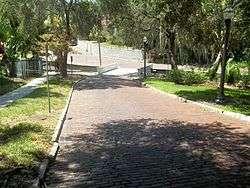Roser Park Historic District
The Roser Park Historic District is a U.S. historic district (designated as such on April 1, 1998) located in St. Petersburg, Florida. The district is bounded by 5th and 9th Streets S, and 6th and 11th Avenues S. It contains 146 historic buildings.
Roser Park Historic District | |
 | |
  | |
| Location | St. Petersburg, Florida |
|---|---|
| Coordinates | 27°45′35″N 82°38′31″W |
| Area | 270 acres (1.1 km2) |
| NRHP reference No. | 98000295 |
| Added to NRHP | April 1, 1998 |
Roser Park was developed in the early years of the 20th century by wealthy developer Charles Roser.[1] Like downtown St. Petersburg, the Historic Roser Park neighborhood is experiencing a renaissance. It has historic character, hilly tree-lined drives and friendly community spirit, and also features close proximity to commercial centers, municipal facilities, hospitals, colleges, arts and entertainment, sporting arenas, boating, beaches and recreation, and regional and international airports.
The 270-acre district is bounded by 4th Street and Dr. Martin Luther King Jr. Street (9th St. S.). to the east and west, and by Booker Creek and Ingleside Avenue (11th Avenue South) to the north and south. The first residential subdivision to be established outside of the downtown St. Petersburg business district, Roser Park was an early "streetcar suburb" conveniently located along the downtown trolley line, and is listed on the National Register for its significance in community planning and development, architecture, and landscape architecture. Located in the Midtown Redevelopment Area, Roser Park also encompasses historic Greenwood Cemetery and one of St Petersburg's most storied creeks.
History
Born in Elryia, Ohio in 1864, Charles Martin Roser foresaw the opportunities that came with purchasing land in Florida during the land boom. He believed that this location would draw the northerners, who lived in very cold climates most of the year, to the warm and sunny climate of what is now Roser Park, FL. It is believed that Roser earned most of his fame and fortune from selling the recipe or baking process of the Fig Newton cookie, to National Biscuit Company (Nabisco).
In 1910, Roser and his wife, Ruth, came to St. Petersburg to establish himself as a developer of this land. His first projects in Florida included the Palm and Poinsettia Hotels, Mound Park Hospitals home for nurses, and Mercy Hospital for black residents. In 1911, he broke ground on the Roser Park development, originally purchasing land from C.D. Hammond, J.P. Lynch, and Alex Linn to get started. From there, he expanded the development from 60 to 80 lots, then began purchasing and renovating subdivisions in the surrounding areas.
One of the last things that Charles Roser built before he passed away in 1937 was the Royal Palm Hotel in 1923, which was located on 5th St S in St. Petersburg. [2]
References
- Boatwright, Josh (April 19, 2014). "Hilly and hidden, St. Pete's Roser Park opens its doors". TBO. Retrieved 2016-07-07.
- "Roser Builds His Vision". Historic Roser Park. Historic Roser Park Neighborhood Association. Retrieved 19 March 2020.